NSB334 Case Study: Unprofessional Behavior in Bariatric Care
VerifiedAdded on 2021/03/08
|10
|2319
|93
Case Study
AI Summary
This case study examines the care of Mr. Driscoll, a bariatric patient post-cholecystectomy, and the actions of two registered nurses. The assignment highlights issues such as the lack of therapeutic communication, potential negligence, and unprofessional behavior, including discriminatory comments related to the patient's weight. It analyzes the RN's failure to adhere to the Nursing and Midwifery Board of Australia (NMBA) and National Safety and Quality Health Service (NSQHS) standards, particularly regarding professional relationships, duty of care, and partnering with consumers. The study emphasizes the importance of interpersonal communication, training, and mandatory reporting to address the identified issues and improve patient outcomes. The case underscores the challenges in bariatric care, the impact of obesity on healthcare, and the necessity of adhering to ethical and professional standards to ensure safe and effective patient care.
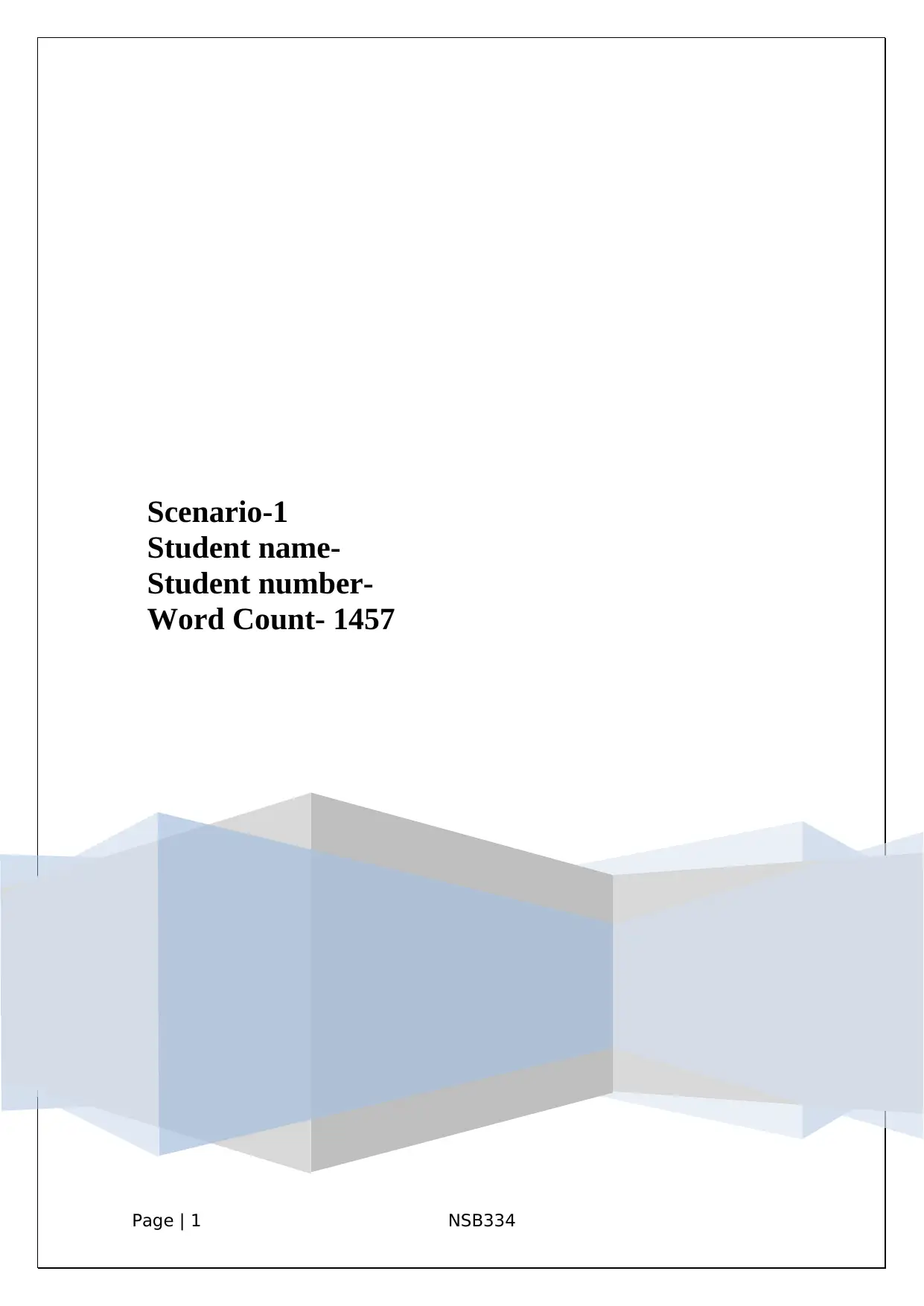
Page | 1 NSB334
Scenario-1
Student name-
Student number-
Word Count- 1457
Scenario-1
Student name-
Student number-
Word Count- 1457
Paraphrase This Document
Need a fresh take? Get an instant paraphrase of this document with our AI Paraphraser
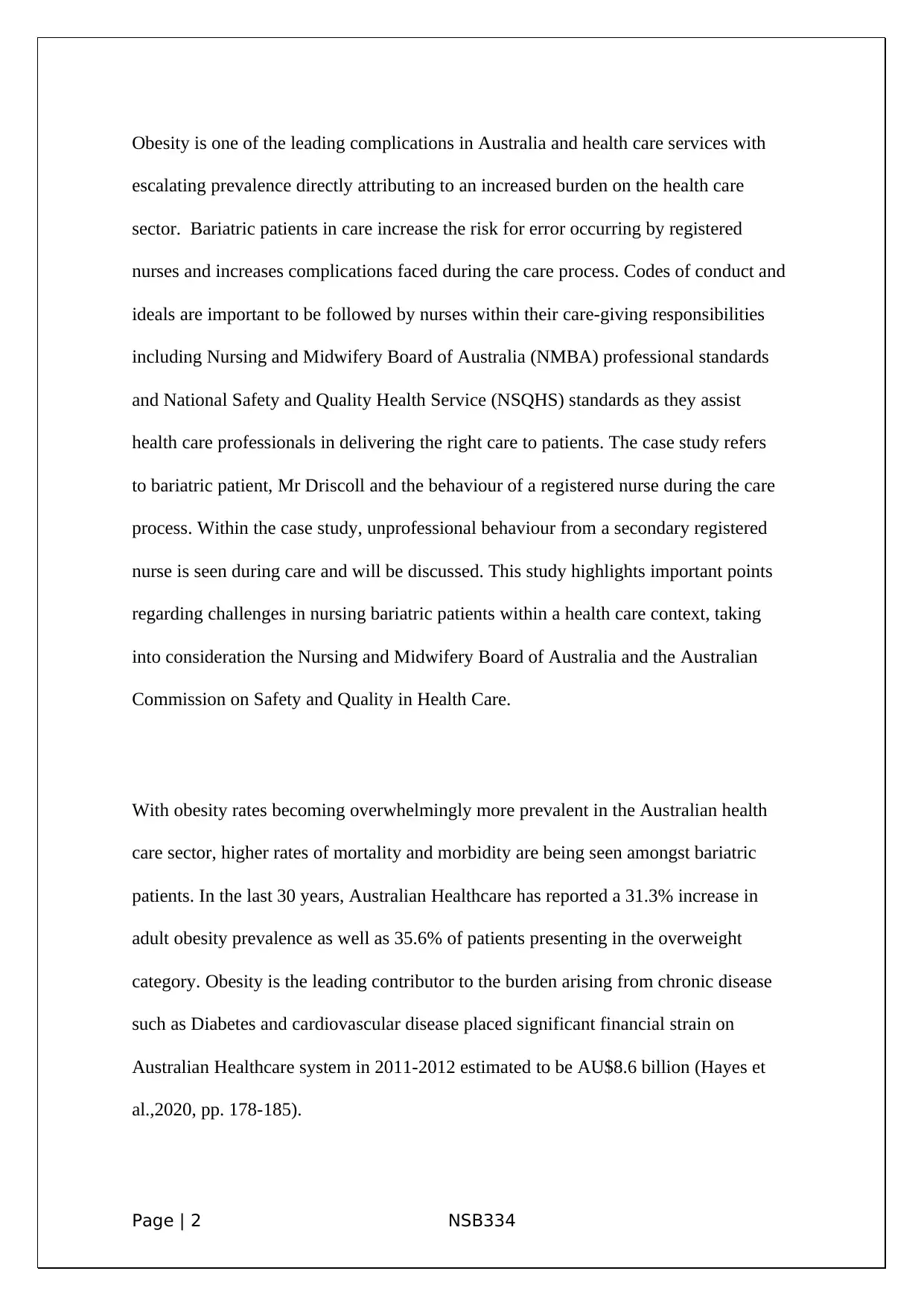
Obesity is one of the leading complications in Australia and health care services with
escalating prevalence directly attributing to an increased burden on the health care
sector. Bariatric patients in care increase the risk for error occurring by registered
nurses and increases complications faced during the care process. Codes of conduct and
ideals are important to be followed by nurses within their care-giving responsibilities
including Nursing and Midwifery Board of Australia (NMBA) professional standards
and National Safety and Quality Health Service (NSQHS) standards as they assist
health care professionals in delivering the right care to patients. The case study refers
to bariatric patient, Mr Driscoll and the behaviour of a registered nurse during the care
process. Within the case study, unprofessional behaviour from a secondary registered
nurse is seen during care and will be discussed. This study highlights important points
regarding challenges in nursing bariatric patients within a health care context, taking
into consideration the Nursing and Midwifery Board of Australia and the Australian
Commission on Safety and Quality in Health Care.
With obesity rates becoming overwhelmingly more prevalent in the Australian health
care sector, higher rates of mortality and morbidity are being seen amongst bariatric
patients. In the last 30 years, Australian Healthcare has reported a 31.3% increase in
adult obesity prevalence as well as 35.6% of patients presenting in the overweight
category. Obesity is the leading contributor to the burden arising from chronic disease
such as Diabetes and cardiovascular disease placed significant financial strain on
Australian Healthcare system in 2011-2012 estimated to be AU$8.6 billion (Hayes et
al.,2020, pp. 178-185).
Page | 2 NSB334
escalating prevalence directly attributing to an increased burden on the health care
sector. Bariatric patients in care increase the risk for error occurring by registered
nurses and increases complications faced during the care process. Codes of conduct and
ideals are important to be followed by nurses within their care-giving responsibilities
including Nursing and Midwifery Board of Australia (NMBA) professional standards
and National Safety and Quality Health Service (NSQHS) standards as they assist
health care professionals in delivering the right care to patients. The case study refers
to bariatric patient, Mr Driscoll and the behaviour of a registered nurse during the care
process. Within the case study, unprofessional behaviour from a secondary registered
nurse is seen during care and will be discussed. This study highlights important points
regarding challenges in nursing bariatric patients within a health care context, taking
into consideration the Nursing and Midwifery Board of Australia and the Australian
Commission on Safety and Quality in Health Care.
With obesity rates becoming overwhelmingly more prevalent in the Australian health
care sector, higher rates of mortality and morbidity are being seen amongst bariatric
patients. In the last 30 years, Australian Healthcare has reported a 31.3% increase in
adult obesity prevalence as well as 35.6% of patients presenting in the overweight
category. Obesity is the leading contributor to the burden arising from chronic disease
such as Diabetes and cardiovascular disease placed significant financial strain on
Australian Healthcare system in 2011-2012 estimated to be AU$8.6 billion (Hayes et
al.,2020, pp. 178-185).
Page | 2 NSB334
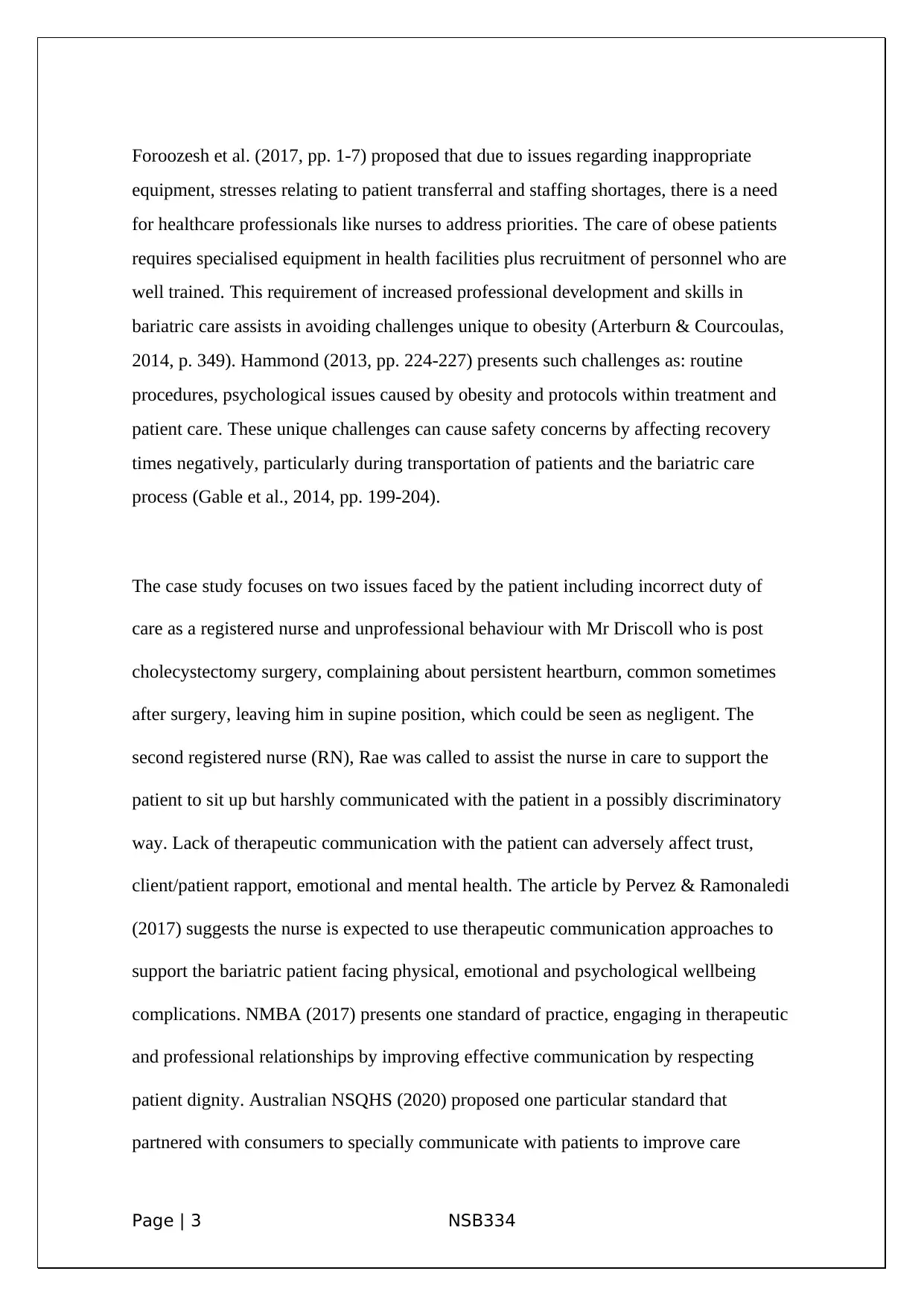
Foroozesh et al. (2017, pp. 1-7) proposed that due to issues regarding inappropriate
equipment, stresses relating to patient transferral and staffing shortages, there is a need
for healthcare professionals like nurses to address priorities. The care of obese patients
requires specialised equipment in health facilities plus recruitment of personnel who are
well trained. This requirement of increased professional development and skills in
bariatric care assists in avoiding challenges unique to obesity (Arterburn & Courcoulas,
2014, p. 349). Hammond (2013, pp. 224-227) presents such challenges as: routine
procedures, psychological issues caused by obesity and protocols within treatment and
patient care. These unique challenges can cause safety concerns by affecting recovery
times negatively, particularly during transportation of patients and the bariatric care
process (Gable et al., 2014, pp. 199-204).
The case study focuses on two issues faced by the patient including incorrect duty of
care as a registered nurse and unprofessional behaviour with Mr Driscoll who is post
cholecystectomy surgery, complaining about persistent heartburn, common sometimes
after surgery, leaving him in supine position, which could be seen as negligent. The
second registered nurse (RN), Rae was called to assist the nurse in care to support the
patient to sit up but harshly communicated with the patient in a possibly discriminatory
way. Lack of therapeutic communication with the patient can adversely affect trust,
client/patient rapport, emotional and mental health. The article by Pervez & Ramonaledi
(2017) suggests the nurse is expected to use therapeutic communication approaches to
support the bariatric patient facing physical, emotional and psychological wellbeing
complications. NMBA (2017) presents one standard of practice, engaging in therapeutic
and professional relationships by improving effective communication by respecting
patient dignity. Australian NSQHS (2020) proposed one particular standard that
partnered with consumers to specially communicate with patients to improve care
Page | 3 NSB334
equipment, stresses relating to patient transferral and staffing shortages, there is a need
for healthcare professionals like nurses to address priorities. The care of obese patients
requires specialised equipment in health facilities plus recruitment of personnel who are
well trained. This requirement of increased professional development and skills in
bariatric care assists in avoiding challenges unique to obesity (Arterburn & Courcoulas,
2014, p. 349). Hammond (2013, pp. 224-227) presents such challenges as: routine
procedures, psychological issues caused by obesity and protocols within treatment and
patient care. These unique challenges can cause safety concerns by affecting recovery
times negatively, particularly during transportation of patients and the bariatric care
process (Gable et al., 2014, pp. 199-204).
The case study focuses on two issues faced by the patient including incorrect duty of
care as a registered nurse and unprofessional behaviour with Mr Driscoll who is post
cholecystectomy surgery, complaining about persistent heartburn, common sometimes
after surgery, leaving him in supine position, which could be seen as negligent. The
second registered nurse (RN), Rae was called to assist the nurse in care to support the
patient to sit up but harshly communicated with the patient in a possibly discriminatory
way. Lack of therapeutic communication with the patient can adversely affect trust,
client/patient rapport, emotional and mental health. The article by Pervez & Ramonaledi
(2017) suggests the nurse is expected to use therapeutic communication approaches to
support the bariatric patient facing physical, emotional and psychological wellbeing
complications. NMBA (2017) presents one standard of practice, engaging in therapeutic
and professional relationships by improving effective communication by respecting
patient dignity. Australian NSQHS (2020) proposed one particular standard that
partnered with consumers to specially communicate with patients to improve care
Page | 3 NSB334
⊘ This is a preview!⊘
Do you want full access?
Subscribe today to unlock all pages.

Trusted by 1+ million students worldwide
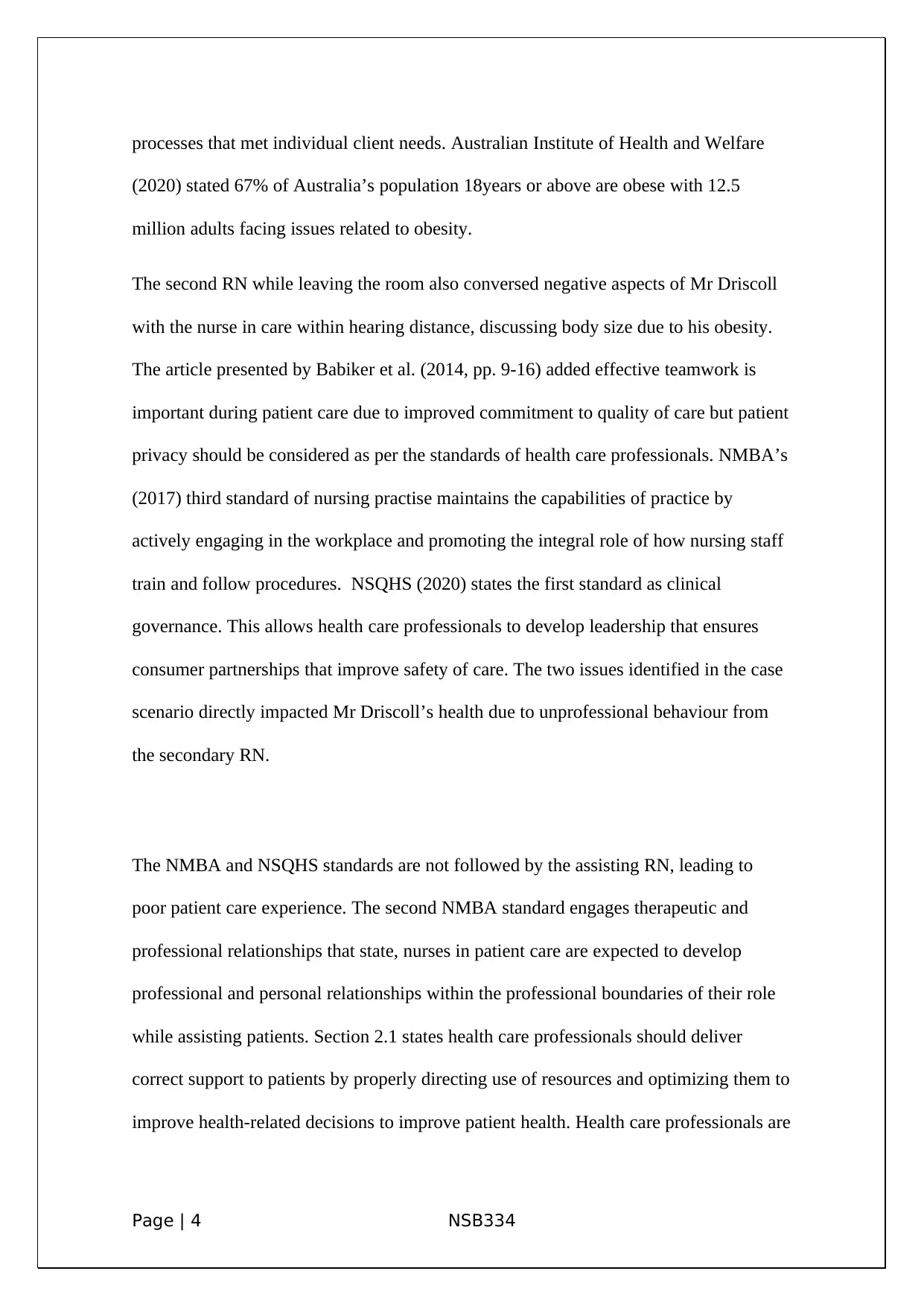
processes that met individual client needs. Australian Institute of Health and Welfare
(2020) stated 67% of Australia’s population 18years or above are obese with 12.5
million adults facing issues related to obesity.
The second RN while leaving the room also conversed negative aspects of Mr Driscoll
with the nurse in care within hearing distance, discussing body size due to his obesity.
The article presented by Babiker et al. (2014, pp. 9-16) added effective teamwork is
important during patient care due to improved commitment to quality of care but patient
privacy should be considered as per the standards of health care professionals. NMBA’s
(2017) third standard of nursing practise maintains the capabilities of practice by
actively engaging in the workplace and promoting the integral role of how nursing staff
train and follow procedures. NSQHS (2020) states the first standard as clinical
governance. This allows health care professionals to develop leadership that ensures
consumer partnerships that improve safety of care. The two issues identified in the case
scenario directly impacted Mr Driscoll’s health due to unprofessional behaviour from
the secondary RN.
The NMBA and NSQHS standards are not followed by the assisting RN, leading to
poor patient care experience. The second NMBA standard engages therapeutic and
professional relationships that state, nurses in patient care are expected to develop
professional and personal relationships within the professional boundaries of their role
while assisting patients. Section 2.1 states health care professionals should deliver
correct support to patients by properly directing use of resources and optimizing them to
improve health-related decisions to improve patient health. Health care professionals are
Page | 4 NSB334
(2020) stated 67% of Australia’s population 18years or above are obese with 12.5
million adults facing issues related to obesity.
The second RN while leaving the room also conversed negative aspects of Mr Driscoll
with the nurse in care within hearing distance, discussing body size due to his obesity.
The article presented by Babiker et al. (2014, pp. 9-16) added effective teamwork is
important during patient care due to improved commitment to quality of care but patient
privacy should be considered as per the standards of health care professionals. NMBA’s
(2017) third standard of nursing practise maintains the capabilities of practice by
actively engaging in the workplace and promoting the integral role of how nursing staff
train and follow procedures. NSQHS (2020) states the first standard as clinical
governance. This allows health care professionals to develop leadership that ensures
consumer partnerships that improve safety of care. The two issues identified in the case
scenario directly impacted Mr Driscoll’s health due to unprofessional behaviour from
the secondary RN.
The NMBA and NSQHS standards are not followed by the assisting RN, leading to
poor patient care experience. The second NMBA standard engages therapeutic and
professional relationships that state, nurses in patient care are expected to develop
professional and personal relationships within the professional boundaries of their role
while assisting patients. Section 2.1 states health care professionals should deliver
correct support to patients by properly directing use of resources and optimizing them to
improve health-related decisions to improve patient health. Health care professionals are
Page | 4 NSB334
Paraphrase This Document
Need a fresh take? Get an instant paraphrase of this document with our AI Paraphraser
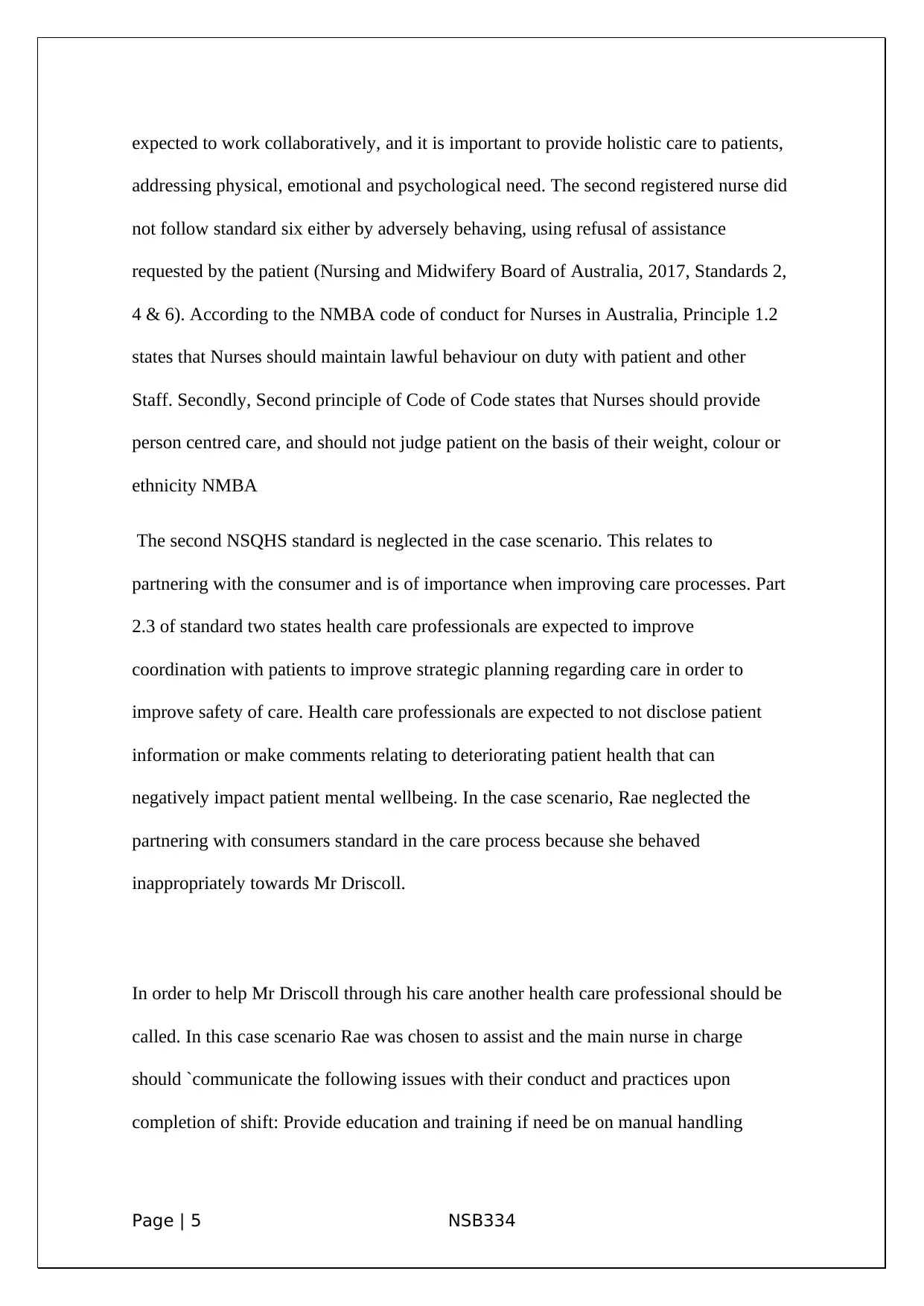
expected to work collaboratively, and it is important to provide holistic care to patients,
addressing physical, emotional and psychological need. The second registered nurse did
not follow standard six either by adversely behaving, using refusal of assistance
requested by the patient (Nursing and Midwifery Board of Australia, 2017, Standards 2,
4 & 6). According to the NMBA code of conduct for Nurses in Australia, Principle 1.2
states that Nurses should maintain lawful behaviour on duty with patient and other
Staff. Secondly, Second principle of Code of Code states that Nurses should provide
person centred care, and should not judge patient on the basis of their weight, colour or
ethnicity NMBA
The second NSQHS standard is neglected in the case scenario. This relates to
partnering with the consumer and is of importance when improving care processes. Part
2.3 of standard two states health care professionals are expected to improve
coordination with patients to improve strategic planning regarding care in order to
improve safety of care. Health care professionals are expected to not disclose patient
information or make comments relating to deteriorating patient health that can
negatively impact patient mental wellbeing. In the case scenario, Rae neglected the
partnering with consumers standard in the care process because she behaved
inappropriately towards Mr Driscoll.
In order to help Mr Driscoll through his care another health care professional should be
called. In this case scenario Rae was chosen to assist and the main nurse in charge
should `communicate the following issues with their conduct and practices upon
completion of shift: Provide education and training if need be on manual handling
Page | 5 NSB334
addressing physical, emotional and psychological need. The second registered nurse did
not follow standard six either by adversely behaving, using refusal of assistance
requested by the patient (Nursing and Midwifery Board of Australia, 2017, Standards 2,
4 & 6). According to the NMBA code of conduct for Nurses in Australia, Principle 1.2
states that Nurses should maintain lawful behaviour on duty with patient and other
Staff. Secondly, Second principle of Code of Code states that Nurses should provide
person centred care, and should not judge patient on the basis of their weight, colour or
ethnicity NMBA
The second NSQHS standard is neglected in the case scenario. This relates to
partnering with the consumer and is of importance when improving care processes. Part
2.3 of standard two states health care professionals are expected to improve
coordination with patients to improve strategic planning regarding care in order to
improve safety of care. Health care professionals are expected to not disclose patient
information or make comments relating to deteriorating patient health that can
negatively impact patient mental wellbeing. In the case scenario, Rae neglected the
partnering with consumers standard in the care process because she behaved
inappropriately towards Mr Driscoll.
In order to help Mr Driscoll through his care another health care professional should be
called. In this case scenario Rae was chosen to assist and the main nurse in charge
should `communicate the following issues with their conduct and practices upon
completion of shift: Provide education and training if need be on manual handling
Page | 5 NSB334
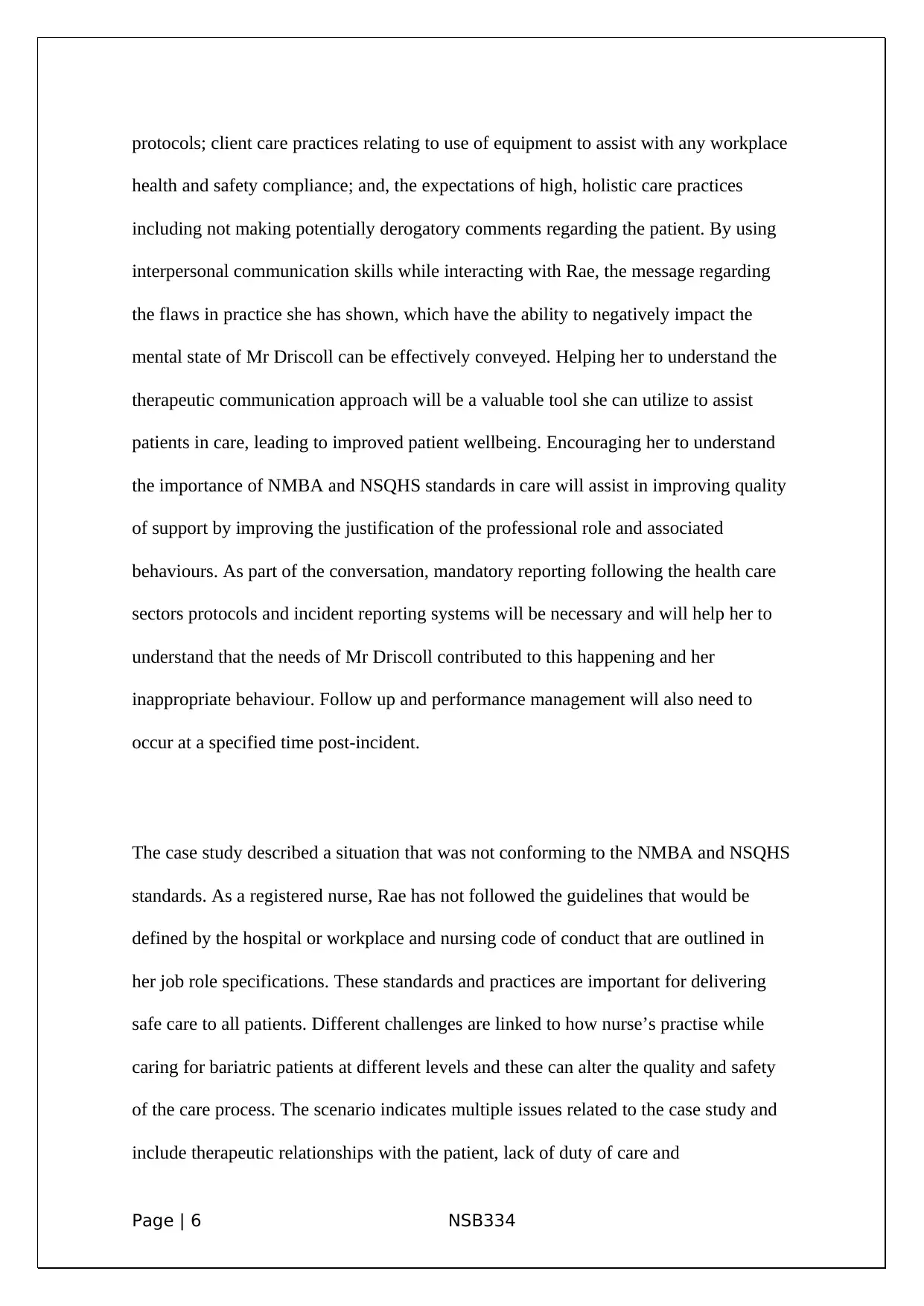
protocols; client care practices relating to use of equipment to assist with any workplace
health and safety compliance; and, the expectations of high, holistic care practices
including not making potentially derogatory comments regarding the patient. By using
interpersonal communication skills while interacting with Rae, the message regarding
the flaws in practice she has shown, which have the ability to negatively impact the
mental state of Mr Driscoll can be effectively conveyed. Helping her to understand the
therapeutic communication approach will be a valuable tool she can utilize to assist
patients in care, leading to improved patient wellbeing. Encouraging her to understand
the importance of NMBA and NSQHS standards in care will assist in improving quality
of support by improving the justification of the professional role and associated
behaviours. As part of the conversation, mandatory reporting following the health care
sectors protocols and incident reporting systems will be necessary and will help her to
understand that the needs of Mr Driscoll contributed to this happening and her
inappropriate behaviour. Follow up and performance management will also need to
occur at a specified time post-incident.
The case study described a situation that was not conforming to the NMBA and NSQHS
standards. As a registered nurse, Rae has not followed the guidelines that would be
defined by the hospital or workplace and nursing code of conduct that are outlined in
her job role specifications. These standards and practices are important for delivering
safe care to all patients. Different challenges are linked to how nurse’s practise while
caring for bariatric patients at different levels and these can alter the quality and safety
of the care process. The scenario indicates multiple issues related to the case study and
include therapeutic relationships with the patient, lack of duty of care and
Page | 6 NSB334
health and safety compliance; and, the expectations of high, holistic care practices
including not making potentially derogatory comments regarding the patient. By using
interpersonal communication skills while interacting with Rae, the message regarding
the flaws in practice she has shown, which have the ability to negatively impact the
mental state of Mr Driscoll can be effectively conveyed. Helping her to understand the
therapeutic communication approach will be a valuable tool she can utilize to assist
patients in care, leading to improved patient wellbeing. Encouraging her to understand
the importance of NMBA and NSQHS standards in care will assist in improving quality
of support by improving the justification of the professional role and associated
behaviours. As part of the conversation, mandatory reporting following the health care
sectors protocols and incident reporting systems will be necessary and will help her to
understand that the needs of Mr Driscoll contributed to this happening and her
inappropriate behaviour. Follow up and performance management will also need to
occur at a specified time post-incident.
The case study described a situation that was not conforming to the NMBA and NSQHS
standards. As a registered nurse, Rae has not followed the guidelines that would be
defined by the hospital or workplace and nursing code of conduct that are outlined in
her job role specifications. These standards and practices are important for delivering
safe care to all patients. Different challenges are linked to how nurse’s practise while
caring for bariatric patients at different levels and these can alter the quality and safety
of the care process. The scenario indicates multiple issues related to the case study and
include therapeutic relationships with the patient, lack of duty of care and
Page | 6 NSB334
⊘ This is a preview!⊘
Do you want full access?
Subscribe today to unlock all pages.

Trusted by 1+ million students worldwide
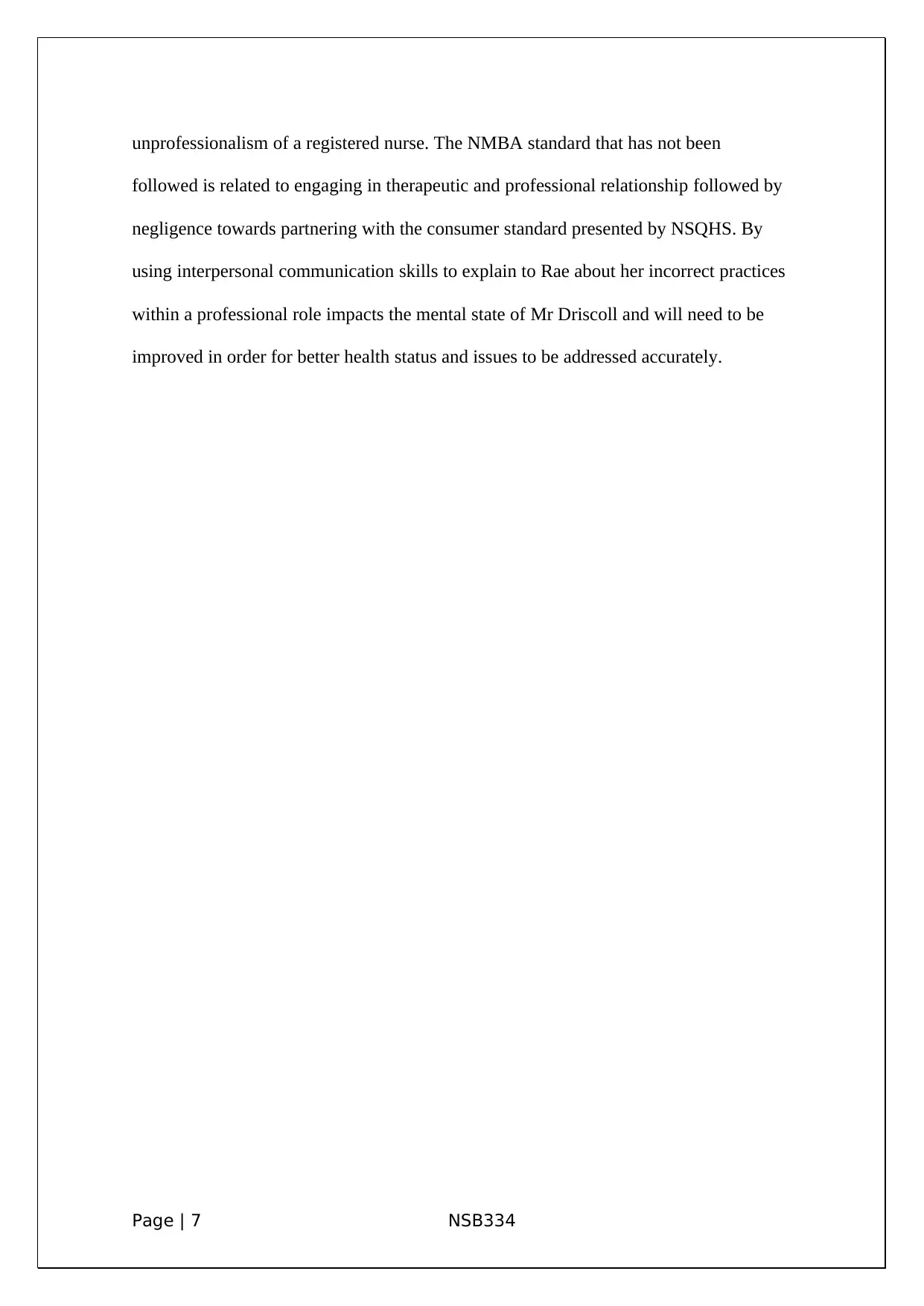
unprofessionalism of a registered nurse. The NMBA standard that has not been
followed is related to engaging in therapeutic and professional relationship followed by
negligence towards partnering with the consumer standard presented by NSQHS. By
using interpersonal communication skills to explain to Rae about her incorrect practices
within a professional role impacts the mental state of Mr Driscoll and will need to be
improved in order for better health status and issues to be addressed accurately.
Page | 7 NSB334
followed is related to engaging in therapeutic and professional relationship followed by
negligence towards partnering with the consumer standard presented by NSQHS. By
using interpersonal communication skills to explain to Rae about her incorrect practices
within a professional role impacts the mental state of Mr Driscoll and will need to be
improved in order for better health status and issues to be addressed accurately.
Page | 7 NSB334
Paraphrase This Document
Need a fresh take? Get an instant paraphrase of this document with our AI Paraphraser
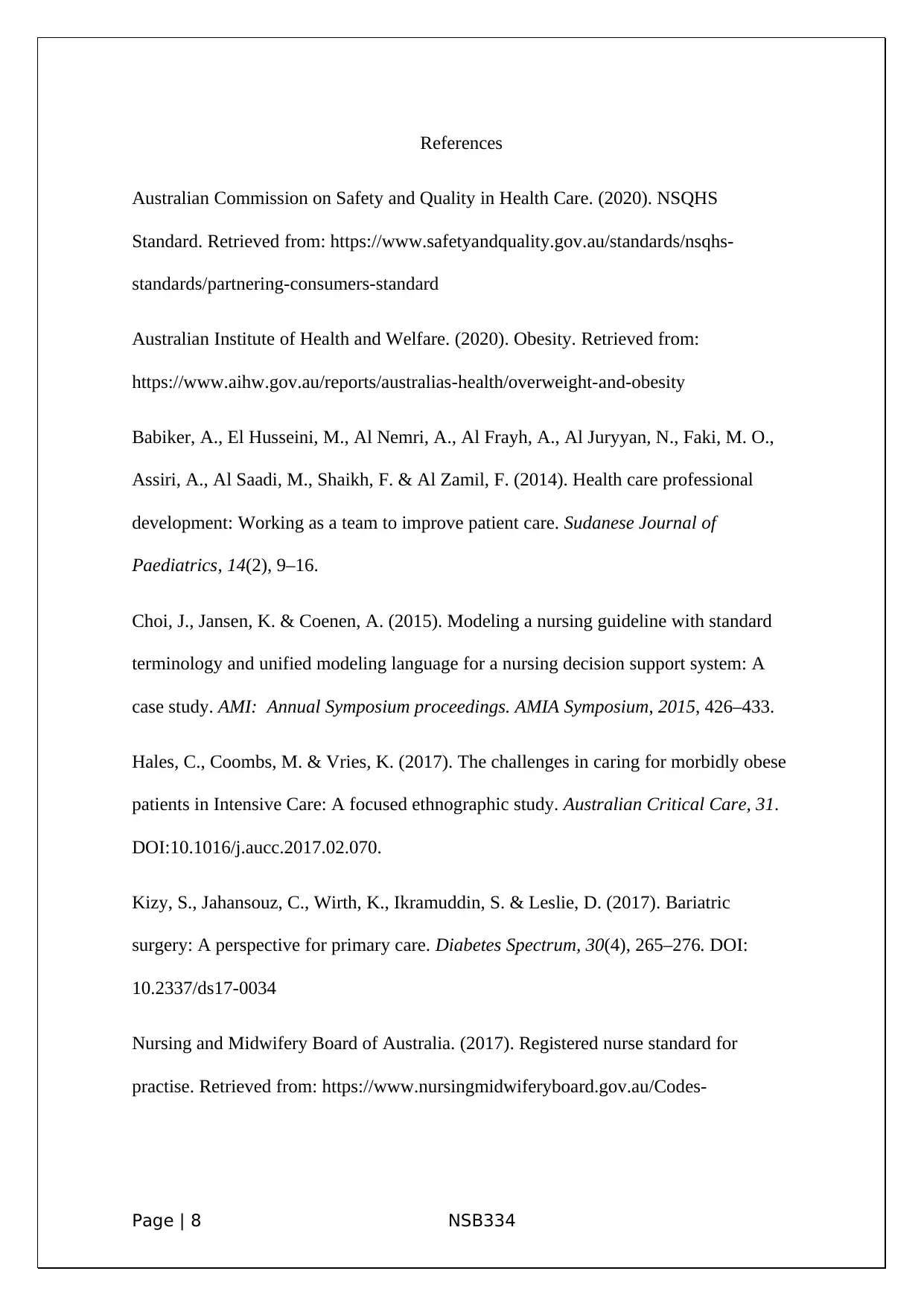
References
Australian Commission on Safety and Quality in Health Care. (2020). NSQHS
Standard. Retrieved from: https://www.safetyandquality.gov.au/standards/nsqhs-
standards/partnering-consumers-standard
Australian Institute of Health and Welfare. (2020). Obesity. Retrieved from:
https://www.aihw.gov.au/reports/australias-health/overweight-and-obesity
Babiker, A., El Husseini, M., Al Nemri, A., Al Frayh, A., Al Juryyan, N., Faki, M. O.,
Assiri, A., Al Saadi, M., Shaikh, F. & Al Zamil, F. (2014). Health care professional
development: Working as a team to improve patient care. Sudanese Journal of
Paediatrics, 14(2), 9–16.
Choi, J., Jansen, K. & Coenen, A. (2015). Modeling a nursing guideline with standard
terminology and unified modeling language for a nursing decision support system: A
case study. AMI: Annual Symposium proceedings. AMIA Symposium, 2015, 426–433.
Hales, C., Coombs, M. & Vries, K. (2017). The challenges in caring for morbidly obese
patients in Intensive Care: A focused ethnographic study. Australian Critical Care, 31.
DOI:10.1016/j.aucc.2017.02.070.
Kizy, S., Jahansouz, C., Wirth, K., Ikramuddin, S. & Leslie, D. (2017). Bariatric
surgery: A perspective for primary care. Diabetes Spectrum, 30(4), 265–276. DOI:
10.2337/ds17-0034
Nursing and Midwifery Board of Australia. (2017). Registered nurse standard for
practise. Retrieved from: https://www.nursingmidwiferyboard.gov.au/Codes-
Page | 8 NSB334
Australian Commission on Safety and Quality in Health Care. (2020). NSQHS
Standard. Retrieved from: https://www.safetyandquality.gov.au/standards/nsqhs-
standards/partnering-consumers-standard
Australian Institute of Health and Welfare. (2020). Obesity. Retrieved from:
https://www.aihw.gov.au/reports/australias-health/overweight-and-obesity
Babiker, A., El Husseini, M., Al Nemri, A., Al Frayh, A., Al Juryyan, N., Faki, M. O.,
Assiri, A., Al Saadi, M., Shaikh, F. & Al Zamil, F. (2014). Health care professional
development: Working as a team to improve patient care. Sudanese Journal of
Paediatrics, 14(2), 9–16.
Choi, J., Jansen, K. & Coenen, A. (2015). Modeling a nursing guideline with standard
terminology and unified modeling language for a nursing decision support system: A
case study. AMI: Annual Symposium proceedings. AMIA Symposium, 2015, 426–433.
Hales, C., Coombs, M. & Vries, K. (2017). The challenges in caring for morbidly obese
patients in Intensive Care: A focused ethnographic study. Australian Critical Care, 31.
DOI:10.1016/j.aucc.2017.02.070.
Kizy, S., Jahansouz, C., Wirth, K., Ikramuddin, S. & Leslie, D. (2017). Bariatric
surgery: A perspective for primary care. Diabetes Spectrum, 30(4), 265–276. DOI:
10.2337/ds17-0034
Nursing and Midwifery Board of Australia. (2017). Registered nurse standard for
practise. Retrieved from: https://www.nursingmidwiferyboard.gov.au/Codes-
Page | 8 NSB334
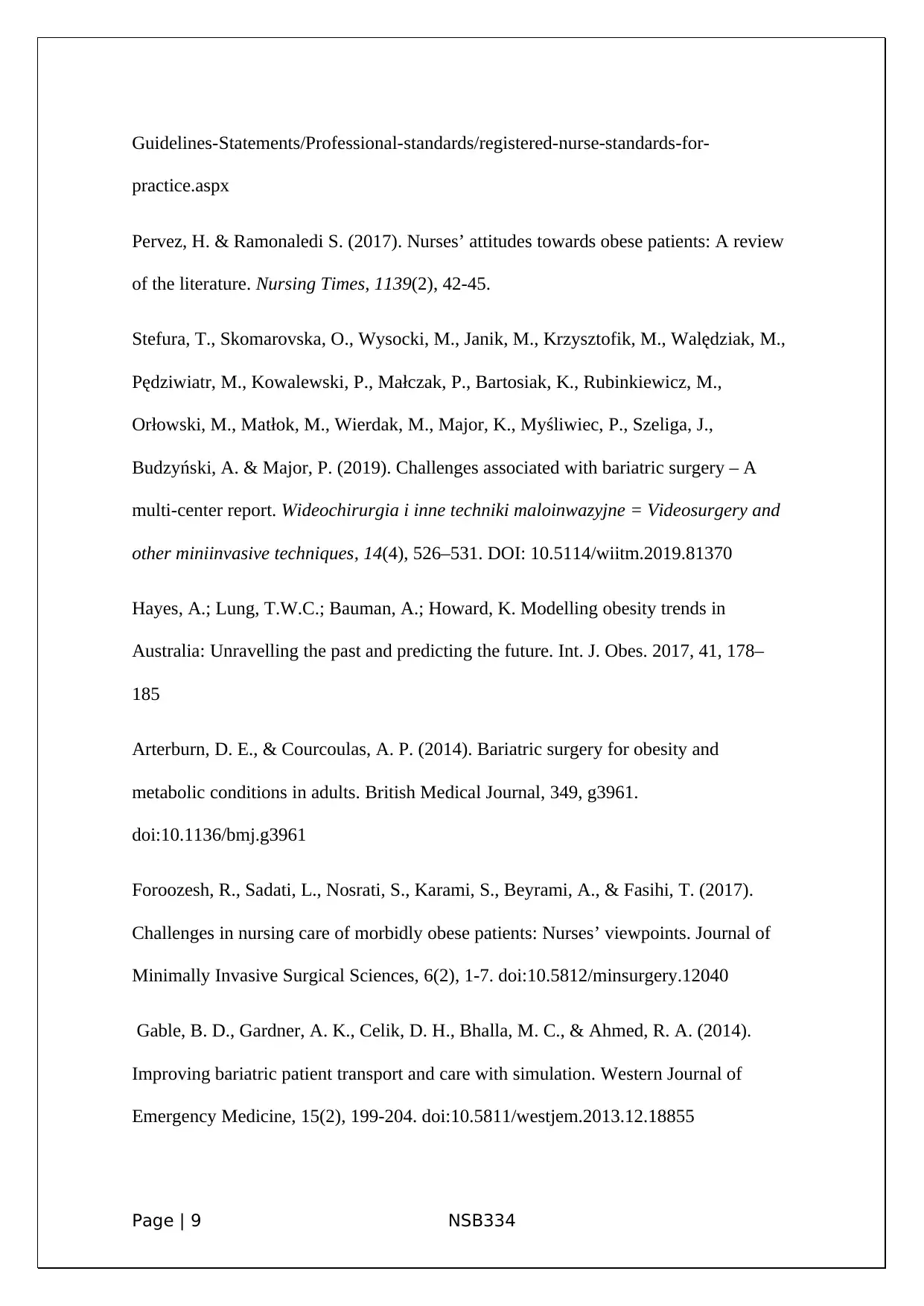
Guidelines-Statements/Professional-standards/registered-nurse-standards-for-
practice.aspx
Pervez, H. & Ramonaledi S. (2017). Nurses’ attitudes towards obese patients: A review
of the literature. Nursing Times, 1139(2), 42-45.
Stefura, T., Skomarovska, O., Wysocki, M., Janik, M., Krzysztofik, M., Walędziak, M.,
Pędziwiatr, M., Kowalewski, P., Małczak, P., Bartosiak, K., Rubinkiewicz, M.,
Orłowski, M., Matłok, M., Wierdak, M., Major, K., Myśliwiec, P., Szeliga, J.,
Budzyński, A. & Major, P. (2019). Challenges associated with bariatric surgery – A
multi-center report. Wideochirurgia i inne techniki maloinwazyjne = Videosurgery and
other miniinvasive techniques, 14(4), 526–531. DOI: 10.5114/wiitm.2019.81370
Hayes, A.; Lung, T.W.C.; Bauman, A.; Howard, K. Modelling obesity trends in
Australia: Unravelling the past and predicting the future. Int. J. Obes. 2017, 41, 178–
185
Arterburn, D. E., & Courcoulas, A. P. (2014). Bariatric surgery for obesity and
metabolic conditions in adults. British Medical Journal, 349, g3961.
doi:10.1136/bmj.g3961
Foroozesh, R., Sadati, L., Nosrati, S., Karami, S., Beyrami, A., & Fasihi, T. (2017).
Challenges in nursing care of morbidly obese patients: Nurses’ viewpoints. Journal of
Minimally Invasive Surgical Sciences, 6(2), 1-7. doi:10.5812/minsurgery.12040
Gable, B. D., Gardner, A. K., Celik, D. H., Bhalla, M. C., & Ahmed, R. A. (2014).
Improving bariatric patient transport and care with simulation. Western Journal of
Emergency Medicine, 15(2), 199-204. doi:10.5811/westjem.2013.12.18855
Page | 9 NSB334
practice.aspx
Pervez, H. & Ramonaledi S. (2017). Nurses’ attitudes towards obese patients: A review
of the literature. Nursing Times, 1139(2), 42-45.
Stefura, T., Skomarovska, O., Wysocki, M., Janik, M., Krzysztofik, M., Walędziak, M.,
Pędziwiatr, M., Kowalewski, P., Małczak, P., Bartosiak, K., Rubinkiewicz, M.,
Orłowski, M., Matłok, M., Wierdak, M., Major, K., Myśliwiec, P., Szeliga, J.,
Budzyński, A. & Major, P. (2019). Challenges associated with bariatric surgery – A
multi-center report. Wideochirurgia i inne techniki maloinwazyjne = Videosurgery and
other miniinvasive techniques, 14(4), 526–531. DOI: 10.5114/wiitm.2019.81370
Hayes, A.; Lung, T.W.C.; Bauman, A.; Howard, K. Modelling obesity trends in
Australia: Unravelling the past and predicting the future. Int. J. Obes. 2017, 41, 178–
185
Arterburn, D. E., & Courcoulas, A. P. (2014). Bariatric surgery for obesity and
metabolic conditions in adults. British Medical Journal, 349, g3961.
doi:10.1136/bmj.g3961
Foroozesh, R., Sadati, L., Nosrati, S., Karami, S., Beyrami, A., & Fasihi, T. (2017).
Challenges in nursing care of morbidly obese patients: Nurses’ viewpoints. Journal of
Minimally Invasive Surgical Sciences, 6(2), 1-7. doi:10.5812/minsurgery.12040
Gable, B. D., Gardner, A. K., Celik, D. H., Bhalla, M. C., & Ahmed, R. A. (2014).
Improving bariatric patient transport and care with simulation. Western Journal of
Emergency Medicine, 15(2), 199-204. doi:10.5811/westjem.2013.12.18855
Page | 9 NSB334
⊘ This is a preview!⊘
Do you want full access?
Subscribe today to unlock all pages.

Trusted by 1+ million students worldwide
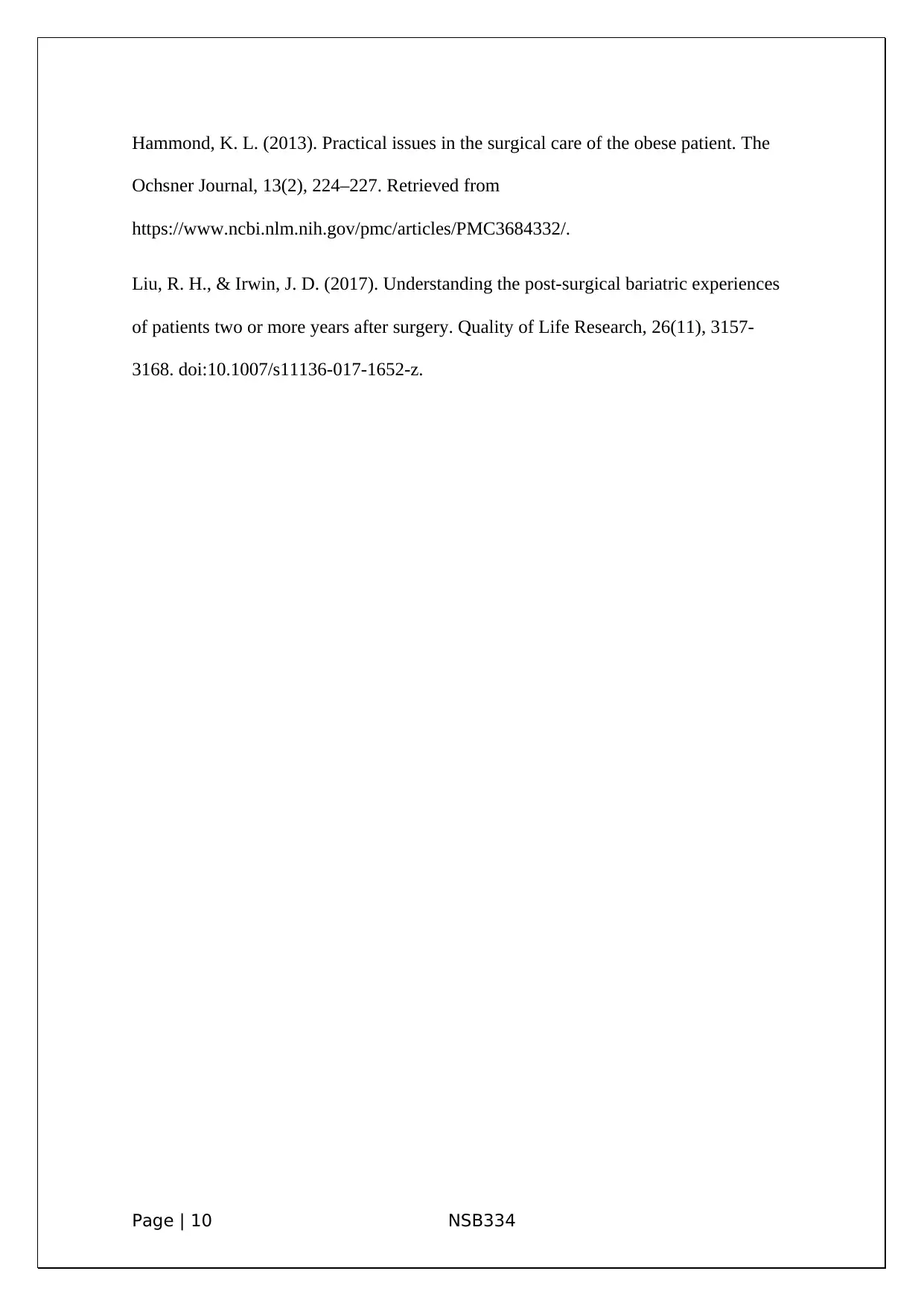
Hammond, K. L. (2013). Practical issues in the surgical care of the obese patient. The
Ochsner Journal, 13(2), 224–227. Retrieved from
https://www.ncbi.nlm.nih.gov/pmc/articles/PMC3684332/.
Liu, R. H., & Irwin, J. D. (2017). Understanding the post-surgical bariatric experiences
of patients two or more years after surgery. Quality of Life Research, 26(11), 3157-
3168. doi:10.1007/s11136-017-1652-z.
Page | 10 NSB334
Ochsner Journal, 13(2), 224–227. Retrieved from
https://www.ncbi.nlm.nih.gov/pmc/articles/PMC3684332/.
Liu, R. H., & Irwin, J. D. (2017). Understanding the post-surgical bariatric experiences
of patients two or more years after surgery. Quality of Life Research, 26(11), 3157-
3168. doi:10.1007/s11136-017-1652-z.
Page | 10 NSB334
1 out of 10
Related Documents
Your All-in-One AI-Powered Toolkit for Academic Success.
+13062052269
info@desklib.com
Available 24*7 on WhatsApp / Email
![[object Object]](/_next/static/media/star-bottom.7253800d.svg)
Unlock your academic potential
Copyright © 2020–2025 A2Z Services. All Rights Reserved. Developed and managed by ZUCOL.





